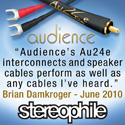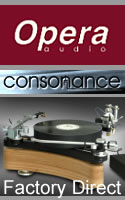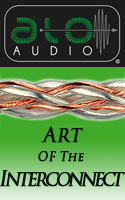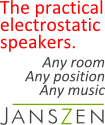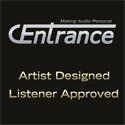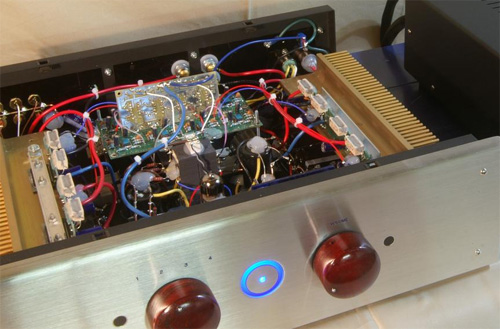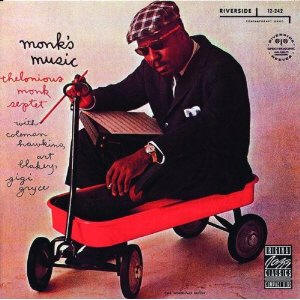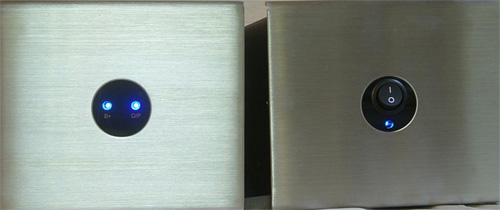|
|
You are reading the older HTML site
Positive Feedback ISSUE 60
blue circle FtTH2 Integrated Amplifier and KQ Power Box as reviewed by Tom Campbell
Blue Circle is a well-established and well-respected audio company that has had an unjustifiably low profile in recent years. One possible reason is that Gilbert Yeung, the company's owner and principal designer, has introduced fewer major new models during that time, often preferring to improve his existing models or to engage his considerable sense of whimsy through items like USB Thingees, Yalu Balulas or Music Pumps. But even Blue Circle's "big" new product introductions as of late have not always received the attention they deserve. That is unfortunate, because the audio press is largely missing out on a significant story. Always an extraordinary engineer, Yeung has refined his skills and his sensibility over the past few years to produce some of the purest-sounding and most exciting amplifiers I've ever had the pleasure of hearing. There are more than a few amps in the middle-range of high-end audio that neither do anything particularly wrong nor anything particularly special: they are competent, sometimes highly so, but often homogenous in their competence – clean and clear, but a bit clinical and blanched of color. Blue Circle amps are different; I've not heard anything else that sounds quite like them. Put simply, they have character—brash, bold, colorful and ingratiatingly warm all at once. One gets the sense they are very much the products of their designer's personality. The item under consideration here is the FtTH2 integrated amplifier. Two years ago, I had the opportunity to spend some time with the first-generation FtTH, which at the time I considered easily the best amplifier I'd heard in my system. It was also the most expensive, so in theory it should have been the best, though we know that audio's more-expensive-is-better maxim does not always hold true. Regardless of any factoring for price however, the FtTH had that something special. A hybrid design with solid-state power output and two 6922 tubes in the gain stage, the amp's power section produced big, butt-kicking, authoritative sound—to me, much more powerful than its 95 watts per channel spec suggested—while the tubed preamp section contributed to a slightly warm tonality that captured the texture and color of acoustic instruments very well.
I did not end up publishing a review of the FtTH back in 2010, largely because by the time I heard it the product was already slated for the graveyard: with the output devices he favored for the amp's design out of production, Yeung planned to retire the FtTH once his stock of the parts ran out. He ended up re-thinking that decision, choosing instead to substantially re-design the amp, using new output devices and reducing the number of tubes in the line stage from two to one. The end result is the FtTH2. On the outside, the 2 looks much the same as the original, the most obvious difference being that whereas the first had separate volume knobs for each channel, there is now a conventional, single volume knob. Separate volume controls were actually a nice feature—allowing you to trim out possible channel imbalances in the amp, in a recording or in your room—but Yeung found that most of his customers preferred a single control and felt he could accommodate them with no loss of quality. Customers who prefer the dual controls can order them as a $300 option; all Blue Circle products are made-to-order for their eventual owners. The FtTH's appearance reflects Blue Circle's philosophy of premium-quality minimalism. The casework is basic but bomb-proof, constructed of stainless steel and not the more common and much cheaper aluminum. There are no superfluous convenience features on the front panel. The only design flourishes are the glowing blue circle—one of the best and most distinctive logos in audio, in my opinion—and the semi-infamous oversized wooden knobs for volume and source selection. You will likely regard these knobs either as plain ugly or so-ugly-they're-kind-of-cool. (Of those two views, I held one and my wife the other. Guess who was who?) If you really can't abide the standard knobs, Blue Circle will sell you fancy stainless steel ones at the punitive cost of $200 each. I don't think Gilbert Yeung likes you dissing his big wooden knobs. The functioning of the volume controls on Blue Circle amps is also idiosyncratic. To preserve the purest possible signal path, the volume knobs are not smooth-turning but "jump" in graduated steps. At the lower end of the knob's rotation, the rise in gain from click to click is considerable, several decibels easily. The further up the knob you turn, the shorter the jumps become from step to step, allowing for more subtle refinement of the gain level.
In my living room, I did most of my listening at the lower end of the control (the FtTH2 is capable of playing tremendously loud). So the relatively large leaps between settings sometimes made it difficult for me to dial in what I considered the "just right" volume. Some may find this frustrating, and I did myself at times, but it is a price of admission to Blue Circle's sound. (There is a partial, built-in recourse, which I did not explore: a switch underneath the knob, outside the amp's casing, that allows you to choose a high or low initial gain setting for the preamp section. At the low setting, you will likely do more of your listening higher up the dial, where the jump between each click is smaller.) The FtTH2, like its predecessor, features a hefty outboard power supply that is connected to the main unit with supplied heavy-duty XLR (i.e. balanced) interconnects. While this two-piece design makes the amp something less than an integrated, the resulting low noise floor—also a product of the balanced topology—makes the required space consideration more than worthwhile. My impressions of the FtTH2 versus the FtTH are based on aural memory rather than side-by-side comparison, but those memories are vivid and the differences clear in my mind. I loved the FtTH and feel the 2 is even better—though each listener's preference will ultimately be subjective. Why? Because while Yeung's coded name for the FtTH—"For the Tube Head"—suggests that tube sweetness was part of his initial design concept, the FtTH2 is faster, livelier and less obviously tube-y. If the original was a cup of strong, black tea with a little bit of honey, the 2 is the same tea straight-up and undiluted.
I hasten to add, though, that the metaphorical tea in question is exceptionally smooth and full-bodied. By no means is the FtTH2 aggressively forward or bright. Through the mid-band, the new amp is largely similar to the first: fleet-of-foot, pure and present, with big images and great depth. But on the 2, the bass is a bit firmer and more tuneful, while the top end of the treble has less of the softened, rounded-off quality associated with tubes—it's not gone, mind you, there's just less of it. In fact, though highly transparent, the new amp retains its predecessor's ability to put some meat on the bones of thin recordings. The additional dollop of subjectivity that Yeung introduces is to make the upper part of the midrange "pop" just a bit, imparting a kind of dynamism and vibrancy that gives the amp a very lively sound without ever crossing the line into harshness. It is an exciting, toe-tapping sound, but not cool or clinical by any stretch. One of my standbys among reference material is Monk's Music, a glorious early stereo recording (1957) that finds Thelonious Monk leading an all-star band including saxophonists John Coltrane, Coleman Hawkins and Gigi Gryce, trumpeter Ray Copeland, bassist Wilbur Ware and drummer Art Blakey. The opening track features the four horns, by themselves, playing a brief, beautiful run-through of the spiritual "Abide with Me." The trumpet leads the way, playing the tune straight while the three saxes follow, soaring over and under the theme with small embellishments.
This 54 seconds of music by itself told me much of what I needed to know about the FtTH2. Lesser electronics blur the four men; good electronics separate them clearly enough; but the Blue Circle amp puts them right there in the room, vividly life-size, each occupying discrete space. Most strikingly, the FtTH2 conveys not just the musicality but the physicality of their playing—you can hear the subtle nuances of each one's breath control, and you can discern the musicians' thinking as they carefully listen to and play off one another. It's hard to express, but in my mind this is a profound thing—a tactile quality that allows you to feel the humanness of the performers, and to hear the music not as disembodied notes but as a true performance. It's an integral part of what we audio people prize in our music playback, and it's that "special something" I'm talking about that separates Blue Circle amps from much of the competition out there. I am embarrassed to admit that I have four different digital versions of Monk's Music: the first CD reissue on Original Jazz Classics; the 2001 re-mastering for the "K2" series, which went back to the mono tapes for the first time in decades; the 2004 SACD edition; and the latest (2011) reissue, which I bought because it was on sale and because, well, I'm a little crazy when it comes to this particular record. Playing the first three tracks of each disc—i.e. the first side of the original LP—the FtTH2 was utterly precise in laying out the differences in each of these mastering efforts. (Long story short, the 1991 edition is the most natural and un-messed-with mastering. The SACD is vivid but has a bit of treble edge, and the newest issue is the most aggressive of all, though neither is terrible by any means. The mono version, recorded simultaneously on separate equipment, presents an entirely different perspective with more room sound, a more forward rhythm section and a warmer, more rounded tone on the horns. Any of the stereo discs will serve you fine, but that hard-to-find mono is an essential counterpart, at least if you love this music as much as I do). Another well-recorded disc like the Naïve label's Vivaldi: Musica per mandolino e liuto, a collection of the baroque composer's chamber music and concertos for lute and mandolin, provides another excellent illustration of the FtTH2's resounding strengths. Rolf Lislevand plays the solo instrument throughout—either lute or mandolin, overdubbing himself to play two mandolins on one concerto—using just his fingers (i.e. no plectrum), producing a soft but exquisitely warm and delicate sound. He is accompanied on the concertos by a small baroque orchestra playing period-correct instruments.
The reproduction of both the soloist and the orchestra on this CD presents challenges to any playback system. I've mentioned this in reviews before, but it's one of my main yardsticks in evaluating equipment: while, in general, live strings sound smooth, silky, and light as a feather, recorded strings tend to sound a bit steely and caustic in comparison. This is a product both of close-mic'd recording techniques as well as the shortcomings of all but the best playback equipment. Baroque-period strings are particularly hard to reproduce. A lot of amplifiers just don't have the resolving power to capture both the acerbic bite of their attack and the pillowy softness of their decay as the sound rises to the ceiling and bounces off the acoustics of the room. The FtTH2, however, does. On the Vivaldi recording, it presented the soft-voiced lute and mandolin leads with beautiful tone and terrific detail, and captured the period orchestra—both the sweet and astringent aspects of its sound—better than any amp I've heard, and by a considerable margin. I listened to the FtTH2 primarily through my Reynaud Orfeo 2 speakers—floorstanders that demand a fair amount of current to really come alive. I had heard that in some rooms the amp, now rated at 100-wpc, might have some trouble driving the big Reynauds to satisfactory levels. I did not find this to be the case at all. The Blue Circle/Reynaud combo filled my 14' by 26' by 8' living room with ease, authority and room-shaking volume. The FtTH2 was also a beautiful match with my smaller, easier-to-drive Spendor SP-3/1 speakers, giving those stand-mounts all they could handle and making them sound bigger than they ever have before. Blue Circle also offers a separately available upgrade to the FtTH2: the KQ power box, another luxuriously appointed shoebox-size unit for your rack. Placed between the main amp and the standard power supply, the box turns this already-two-piece "integrated" into a three-piece. Functionally, it greatly enhances the power filtering capabilities of the FtTH2 as an amplification system—upping the standard unit's 210,000uF of filtering by an additional 450,000uF. Without going into an explanation of what micro-farads (uF) are, the intended effect is simply to make the amp more efficient in the way it stores and delivers current, theoretically resulting in lower distortion, improved clarity and the perception of increased power. After listening to the standard FtTH2 for a couple of weeks, I placed the KQ into the system. Putting it through its paces, I found the improvement rendered to be dependent on the type of music being played. With orchestral classical music, it really made a significant, positive difference. The 2004 reissue of Paul Paray and the Detroit Symphony's famed ‘50s recording of the music of Chabrier—part of the short-lived Mercury Living Presence SACD series – bears all of the hallmarks of the Mercury sound: a thrillingly close perspective, hairpin dynamics and an aggressively forward tonal balance. Through the standard FtTH2, the recording retained its brilliance but also seemed to show its age, sounding a bit wooly and more than a bit bright. The KQ, though, really smoothed out the bumps, delivering as advertised a deeper, quieter background, more dynamic ease, and an overall more fluent and liquid sound. Essentially, it solved the challenges of the recording.
On less dynamically demanding music, the KQ made less of a difference. My local Newbury Comics chain is offering a large selection of Fantasy's Original Jazz Classics and Original Blues Classics reissues at close-out prices of $4 or $6 apiece, and I've been feasting on 3 or 4 a week for the past several weeks. These are superb transfers of classic sessions from the likes of Barney Kessell, Johnny Griffin, Jimmy Witherspoon and Lightnin' Hopkins, and I played a slew of them during my month with the FtTH2. On these mostly small-band dates, the KQ upgrade made a more marginal improvement—a bit more refinement, a bit more clarity and solidity. If your tastes run mainly toward rock, pop, jazz or other smaller-scale music, I would regard the KQ box more as a nice-to-have than a need-to-have. If you are a classical music lover, I would regard it as near-essential, either purchased with the amp or added at a later date to space out the costs. My current everyday amp is the Ayon Audio Orion all-tube integrated. I love the Orion—at its price point of circa $3K, it is a brilliant design, with high musical performance and superb build quality. It is also the quietest and most glitch-free tube amp I've encountered, having now spent more than 2 years as my main amp with no tube failures, microphonics or noise issues of any kind. All that said, I am aware of its limitations: while it is tonally rich, even and accurate from the top to bottom of its range, and more extended at the top and bottom than many similarly designed amps, it can't compete with the big boys in terms of range or dynamics or the kind of black, black backgrounds that distinguish top-rank components. Nor would one expect it to. The FtTH2 costs about twice as much as the Orion—almost three times more, if you include the KQ—but, in my opinion, it gets you up into the big leagues. It's the first amp I've had in my home that really made me think, "How much better does it really get?" In normal-sized rooms, and assuming it is powerful enough to drive your speakers, the FtTH2 will bring you pure, powerful, undistorted, authoritative music-making. You can spend a great deal more money, but in my opinion, this amp is in a class where doing so only gets you severely diminishing returns. Depending on the type of audiophile you are, you may regard this integrated amp as a weigh station on the journey to some exalted, perhaps illusory, ideal. Or you may, like me, marvel at the sound of the FtTH2 and say, "How much better does it really get?" Tom Campbell
Blue Circle FtTH2 integrated amplifier
Blue Circle KQ Power Box
Blue Circle
|
